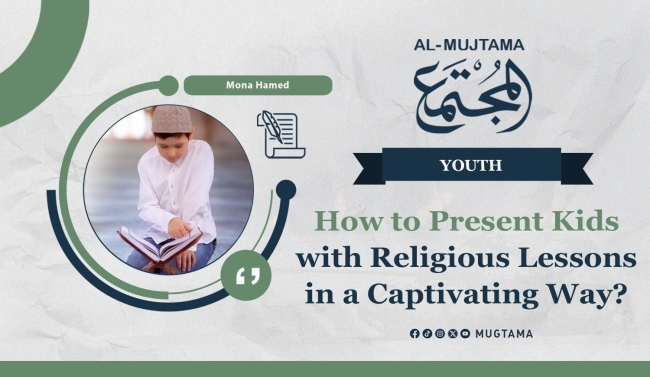How to Present Kids with Religious Lessons in a Captivating Way?
Many parents ask the question titled in the article, in light of the increasing magical influence of the “media” on the minds and souls of their children compared to a religious discourse that many of their children do not find attractive, which causes parents to fear for the future of their beloved children.
Raising children to understand and live by religion is not only part of traditional home education but also the responsibility of the platforms of dawah in building a society based on values. These platforms represent the voice of Islam to children whose minds and souls are still developing. This is where the current situation becomes dangerous. With the increasing challenges facing children in today's world, the religious discourse directed at them needs careful study that takes into account their psychological and cognitive development and adopts modern tools that help make religious values and concepts appealing to them.
To understand how to present an attractive religious discourse to children, it is necessary to understand their psychological and cognitive development at different stages, which is detailed in Jean Piaget's theory, one of the most important theories in psychology.
According to the theory, children in early childhood begin with “symbolic thinking,” where they learn through stories and images. This means that presenting religious concepts should be done in a storytelling and visual manner that attracts their attention and helps them understand religious symbols. Quranic stories, especially the stories of the prophets, are ideal content for children's religious upbringing, only if they are presented in a simple, illustrated manner without personifying the prophets according to Islamic Sharia.
This method can contribute to developing a spiritual connection in our children. Contemporary psychological studies confirm that children at this stage need imaginative and cognitive stimulation to interact with the world around them. Therefore, religious discourse should be presented to children through engaging Quranic stories that reinforce religious values in their hearts and link daily behaviors to faith concepts.
This means that presenting the religious message to our children should avoid the traditional rote learning method that relies on presenting information without interaction. This is based on the nature of children's psychological composition, let alone when the opposite values and message of religion are presented by the devils of humanity in the most appealing form!
Utilizing Images
For example, if we combine educational games and electronic applications and teach children how to perform Wudu’ or pray in an engaging way, we will be utilizing images correctly for building their faith. Here, contemporary media such as cartoons or illustrated stories can be beneficial.
Additionally, religious values can be reinforced through training children in various daily life activities that simulate real-life situations they observe in their parents' lives. For instance, when a parent goes out with the child to participate in a simple charitable act, like giving money to the poor, and repeats the prophetic saying: “The wealth of a man will not diminish by Sadaqah (charity).” (Narrated by Muslim), it has a profound impact on the child.
By combining images and stories interactively, we fully employ these tools to serve the religious message, which children find attractive and enjoyable, unlike the traditional rote learning method that is burdensome for adults, let alone children.
From this standpoint, family activities are the primary factor in a child's religious upbringing, as it is the first environment where they are exposed to values. If the child sees their parents committed to praying and encouraging them through interactive storytelling, the child will feel a sense of belonging to the religion as a source of joy and beauty in life, as mentioned in the prophetic saying: “O Bilal, give us comfort by it.” (Narrated by Abu Dawood)
Educational institutions, whether schools or educational centers, also have a complementary and important role. They should adopt educational curricula that combine academic and moral education and ensure that religious concepts are part of daily education, not just separate lessons.
Using games, cartoons, competitions, and trips within schools can effectively motivate children to understand and memorize parts of the Quran or some prophetic hadiths, thereby strengthening their connection to religion as a fundamental part of their identity rather than a duty to be fulfilled.
The challenges facing children today require innovative solutions to enhance the religious discourse directed at them, especially given the excessive exposure to global media that often promotes concepts contrary to Islamic values.
To overcome this problem, parents play a crucial role in determining the content their children are exposed to, along with the shared responsibility of content providers to offer suitable religious content for children through applications like “Muslim Kids TV” and others that combine education and entertainment.
Furthermore, educational institutions in our countries must adopt comprehensive religious curricula that align with technological advancements, using modern tools such as virtual reality applications that help children experience rituals like Hajj or Umrah interactively, thereby deepening their understanding of these rituals.
Renewing religious discourse for children has become a necessity, not only by updating the language but through a comprehensive development process based on a deep understanding of children's cognitive and psychological needs, ensuring that religion is a natural part of a child's daily life by strengthening the relationship between the teachings of the Quran and daily experiences.
However, preparing a successful religious discourse for children requires the participation of all parties, starting with the family, which is the first to impart religious values, passing through educational institutions that should provide appropriate curricula, and reaching media outlets that must offer attractive and beneficial content that enhances the correct understanding of religion. Therefore, the issue requires intervention at the state level—so who will rise and carry this responsibility in its new form?
-------------------------------------------------------------


